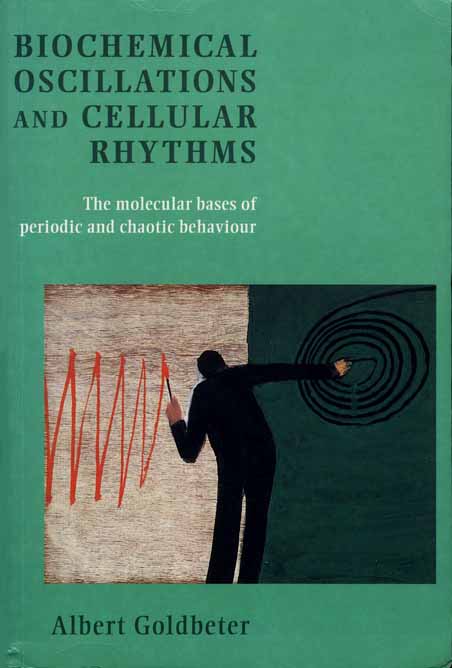
|
CONTENTS
- 1. Introduction
- 2. Oscillatory enzymes: simple periodic behaviour in an allosteric model
for glycolytic oscillations
- 3. Birhythmicity: coexistence between two stable rhythms
- 4. From simple periodic behaviour to complex oscillations, including
bursting and chaos
- 5. Models for the periodic synthesis and relay of cAMP signals in
Dictyostelium discoideum amoebae
- 6. Complex oscillations and chaos in the cAMP signalling system of
Dictyostelium
- 7. The onset of cAMP oscillations in Dictyostelium as a model for the
ontogenesis of biological rhythms
- 8. Function of the rhythm of intercellular communication in
Dictyostelium:
Link with pulsatile hormone secretion
- 9. Oscillations and waves of intracellular calcium
- 10. Modelling the mitotic oscillator driving the cell division cycle
- 11. Towards a model for circadian oscillations in the Drosophila
period protein (PER)
- 12. Conclusions and perspectives
|
Summary
This book addresses the molecular bases of some of the most important
biochemical rhythms known at the cellular level. Clarifying the mechanism of
these oscillatory phenomena is of key importance for understanding the
origin as well as the physiological function of these rhythms, and the
conditions in which simple periodic behaviour transforms into complex
oscillations including bursting and chaos.
The approach rests on the analysis of theoretical models closely related
to experimental observations. Among the main rhythms considered are glycolytic
oscillations observed in yeast and muscle, oscillations of cyclic AMP in
Dictyostelium amoebae, intracellular calcium oscillations observed in
a variety of cell types, and the mitotic oscillator that drives the cell
division cycle in eukaryotes. For each of these phenomena, experimental facts
are reviewed and mathematical models presented. These models throw light on the
mechanism of periodic behaviour at the molecular and cellular levels and show
how enzyme regulation or receptor desensitization can give rise to oscillations.
The theoretical models are also used to analyse the transition between simple
periodic oscillations and more complex oscillatory phenomena such as
birhythmicity (i.e. the coexistence between two stable rhythms), bursting
oscillations and chaos. The model for cyclic AMP oscillations in
Dictyostelium is further used to discuss the function of pulsatile
signalling in intercellular communication. The frequency encoding of cyclic AMP
signals is related to the fact that many hormones are secreted in pulses whose
frequency governs their physiological effect.
This book which contains more than 1200 references, provides a wide survey of
work on biochemical oscillations and cellular rhythms. The author has made
numerous contributions to the subject since the early developments in the
field.
The book will be of interest to life scientists such as biochemists, cell
biologists, chronobiologists, medical scientists and pharmacologists. In
addition, it will appeal to scientists studying nonlinear phenomena, including
oscillations and chaos, in chemistry, physics, mathematics and theoretical
biology.
From the Foreword by M. J. Berridge:
'I [have begun] to appreciate the value of good modelling, especially now that we have learnt so much more about
the basic biochemical details regulating cellular activity. For each system now being investigated, there are so
many variables that it becomes impossible to use our intuition to assess how each parameter influences the
oscillatory cycle. The only way to understand these biological rhythms, therefore, is to become more quantitative
and to develop rigorous mathematical models. Albert Goldbeter is at the very forefront of this new
approach.'
From reviews of the hardback edition:
`Albert Goldbeter ... is a reliable guide through the intricacies of the biochemistry and mathematics ... The great
strength of the book is his unshrinking dedication to understanding these
processes from start to finish ... The book
is conversational, clear and accurate ... The volume is loaded with experimental data, hypothetical mechanisms,
differential equations, numerical simulations and careful comparison between
theory and observations.' J. J.
Tyson, Nature
`It is this coincidence of interpreting molecular details and unfolding common principles which makes the book
by Albert Goldbeter a source of sustained intellectual joy.'
A. Deutsch, Biomathematics Newsletter
`The book beautifully illustrates the art of modelling ... The author bas been studying the theory of oscillations
and rhythms for 25 years and brings a great deal of experience to bear on
this book ... It is an excellent read and
will appeal to a wide-ranging audience, from students moving into the area to established researchers in the field,
and from mathematical modellers to experimentalists in the life sciences.'
P. Maini, Trends in Biochemical
Sciences
`... will undoubtedly become a classic in the field of
mathematical modelling of cellular processes. With all of its
details, it is not a book that is easily read. On the other hand, I will enjoy having the book on my bookshelf for
consultation, and I am confident that it will serve me well for many years.'
L. F. Olsen, Bulletin of
Mathematical Biology
`The focus of the book is as illuminating as its content. Here the focus is on defining and understanding the
central components of oscillators and how they interact to produce oscillations. ... Goldbeter is to be
congratulated for persevering in pulling together an enormous and disparate body of literature in a coherent and
readable manner. ... I predict that this book will remain useful for a long time.'
J. Dunlap, Endeavour
`A very impressive tome and a superb addition to the literature. It is quite clearly going to be the reference book
on oscillations.' J. D. Murray (University of
Washington, Seattle)
`His book will be essential reading for any investigator who wants a systematic introduction to this crucial area of
biological research.' P. Rapp (Physiology, Medical
College of Pennsylvania)
ULB - UTC: Biochemical Oscillations and Cellular Rhythms / Revised :


